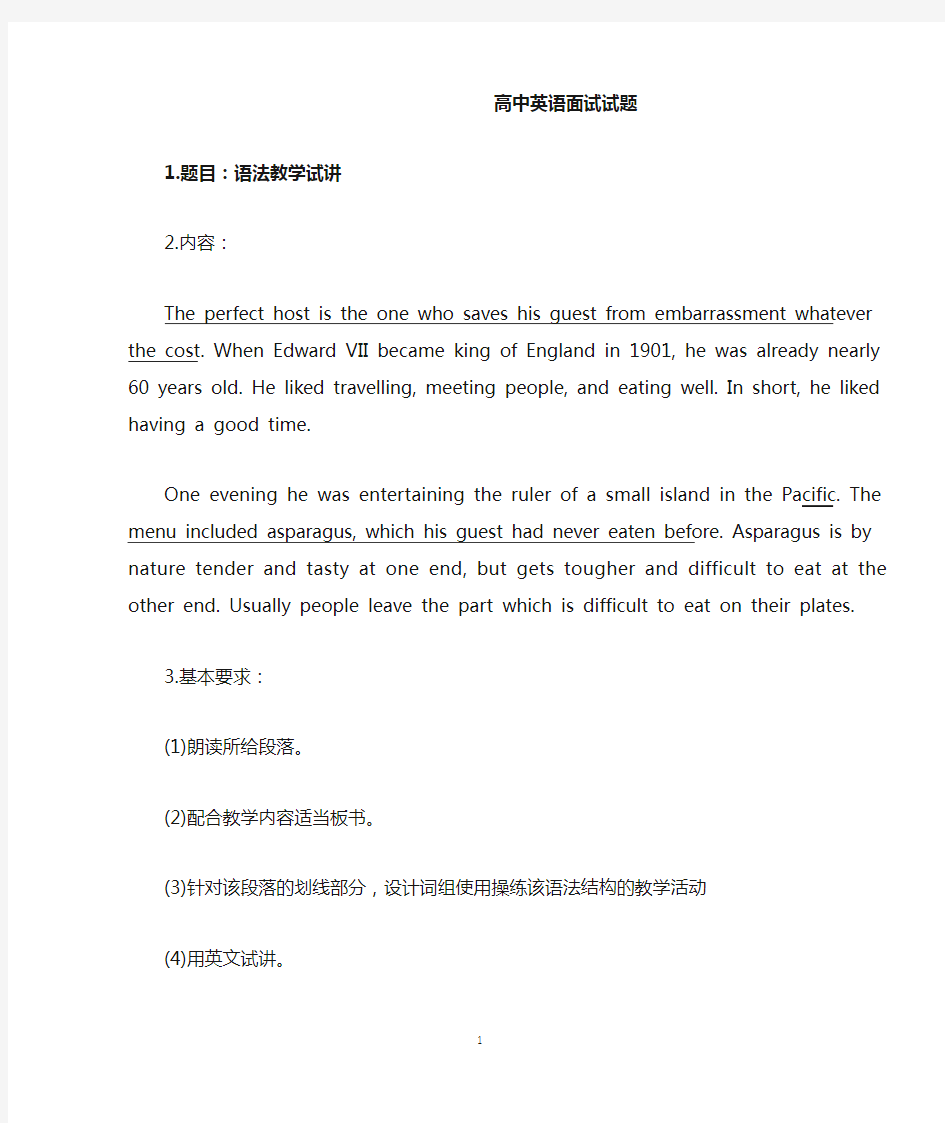
高中英语面试试题
- 格式:docx
- 大小:47.71 KB
- 文档页数:11


高中英语面试试题
1.题目:语法教学试讲
2.内容:
The perfect host is the one who saves his guest from embarrassment whatever the cost. When Edward VII became king of England in 1901, he was already nearly 60 years old. He liked travelling, meeting people, and eating well. In short, he liked having a good time.
One evening he was entertaining the ruler of a small island in the Pacific. The menu included asparagus, which his guest had never eaten before. Asparagus is by nature tender and tasty at one end, but gets tougher and difficult to eat at the other end. Usually people leave the part which is difficult to eat on their plates.
3.基本要求:
(1)朗读所给段落。
(2)配合教学内容适当板书。
(3)针对该段落的划线部分,设计词组使用操练该语法结构的教学活动
(4)用英文试讲。
(5)试讲时间:10分钟
答辩题目
1.What’s the important point in your class, how did you deal with the important port in your class?
2.Being a teacher is tired and the salary is not high, why do you choose to be a teacher?
二、考题解析
【教案】
Teaching aims:Students will learn the differences between restrictive attributive clause and non-restrictive attributive clause.
Knowledge aims:Students can know some rules of non-restrictive attributive clause. Ability aim:Students can use restrictive attributive clause and non-restrictive attributive clause to make sentences and communicate with the sentences in their daily life.
Students can improve their analyzing ability by reading the passage.
Emotional aim:Students will be more interested in English culture after learning this article.Students can increase the awareness of cooperation with others by joining in various activities
Key and difficult point:
Key Point:comprehend the differences between restrictive attributive clause and non-restrictive attributive clause.
Difficult Point: use restrictive attributive clause and non-restrictive attributive clause to make sentences and communicate with the sentences in their daily life and have the awareness of cooperation with others.
Teaching procedures:
Step 1: Warming-up
1.Greeting
2.Show them a video about Edward VII “Who is he?”, while talking with students, use some sentences with restrictive attributive clause and non-restrictive attributive clause.
Step 2: Presentation
1.Ask students to open the book and reads the passage and ask students “What’s the main idea of this passage?”.
2.Ask students to read the passage again and circle the sentences which are similar to that are shown them before. Then invite a student write down the sentences on the blackboard.
1).The menu included asparagus, which his guest had never eaten before.
2).Usually people leave the part which is difficult to eat on their plates.
3. Let students discuss the function with group members and then make the conclusion of function and structure of grammar.
Function:1).restrictive attributive clause: modify and qualify the antecedent.
2).non-restrictive attributive clause: modify and qualify the sentences or part of sentences.
Structure: 1).antecedent+which+restrictive attributive clause
2).sentence,+which+non-restrictive attributive clause
Step 3: Practice
Ask students use the simple sentences to change into restrictive attributive clause and non-restrictive attributive clause.
Step4: Production
Group of 5, give students 5 minutes to discuss “what should we do when there are some guests come our home?” and tell them and when they discuss, they need to use the grammar as much as they can. After that, invite some group share their ideas. Step5: Summary and Homework
Summary: ask a student to the function structure of the grammar and structure. Homework: Try to surf on the Internet and find more information about Edward VII and write down the rules of relational words in restrictive attributive clause.
【答辩题目解析】
1. What’s the important point in your class, how did you deal with the important port in your class?
【参考答案】